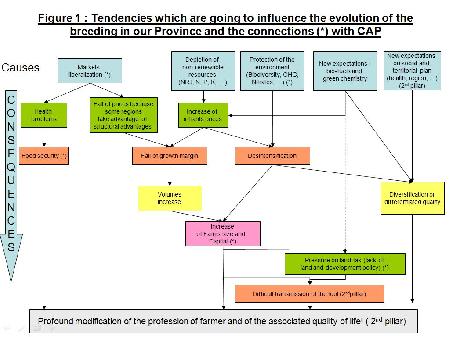Context
Breeding sector and more especially cattle breeding sector face important difficulties. It is marked by sanitary, economic and environmental crisis and, also, by a deep identity crisis. Now, this sector, representing 60 % of the Belgian agricultural production value, concerns more than 90 % of the farms and 95 % of the territory of Luxembourg Province.What are the possible evolutions, the possible futures for this sector at short (CAP reform expected for 2013-2014) and at longer terms (2025) in the context of (1) worldwide product exchange, direct competition with breeding systems working with lower production costs, (2) production costs increase in a context of non-renewable energy depletion?Objectives
In such context, this project aims:
(1) to explore the factors that, at short (5 years) and at longer (15 years) ranges, are susceptible to impact agriculture future;
(2) to identify the possible ways, and their acceptation by the different actors of the territory, of agriculture adaptation to these evolutions;
(3) to define the economical and social stakes fitting with these different futures;
(4) to drive, in a participative way, the affected actors towards a positive attitude to evaluate, to integrate the different evolutions highlighted;
(5) to adapt the agricultural policy (funding targeting, ..) and the advisory services (training, decision support tools, …) in the province to face the identified challenges..
Expected results
1. A fine description of the evolution of this sector and of the CAP with the identification of the main trends of this evolution;
2. An identification of the possible evolution scenarios at short (5 years) and at longer (15 years) terms;
3. A modelling of the impact of these different scenarios on farming systems performances;
4. An identification of the main stakes for the actors of the different sectors under concern and the development of a participative work on the more suitable scenario in order to go further than the conception phase ;
5. An action plan to go further in the action …
Results obtained
1) The stakes
A first step, after the definition of the past and current place of agricultural sector in Luxembourg Province, was to define the main stakes this sector has to face in a near or longer future (fig. 1). Among these stakes, CAP evolution will play a major role. A workshop organised on this topic highlights four main trends :
- the suppression of market regulation tools (production rights, price support, …);
- a standardised premium, per ha, at a geographical scale to be determined;- the reinforcement of CAP 2nd pillar taking into account the rural development;
- an increase of the attention paid to environmental dimensions.These exchanges also underline the low weight of our agricultural sector in the worldwide exchanges but its key role at local market scale. So it is necessary to valorise the proximity existing between agricultural sector and important urban centres with important consumption potential.Economical viability of this sector will need :
- a reduction of the production costs (better integration of grass and rough fodder resources in livestock diet, reduction of investment costs, …),
- to highlight the positive environmental impact of local livestock farming systems based on grassland valorisation (limitation of energy consumption and of GHG emissions due to limited transportations, carbon stocking capacity of grassland ecosystem, positive impact of this agro-ecosystem on landscape structure and to sustain biodiversity).So it is necessary to connect energy balance, food production autonomy and social impact of the different possible future to be identified.Due to their size increase, farm transmission from one generation to the other was an other problem highlighted during this workshop.
2) Possible scenarios
On the basis of these stakes and workshop outputs, different scenario are under analysis :
- with a pursuit of present trends;
- with an increase of livestock production industrialisation;
- with a research of a greater agreement between national production and consumption in taking into account good feeding
3) Main systems characterisation and modelling
Nineteen main types of livestock farming systems are identified in Luxembourg Province with, mainly, cattle beef systems that differentiate themselves (1) on the basis of their intensification level, reflected by animal stocking rate (BLU/ha) and (2) the proportion of maize on the Used Agricultural Surface.
The operation of the “V Intensive Beef Cattle based on Grass” (VIBG) type, including 25 % of the farms, was modelled, this model is under the validation phase.
The Second more frequent type is the ‘Very Extensive Beef Cattle” corresponding to 10 % of the farms.We ca also underlined that the distribution of these types is far to be homogeneous across the Province. For example, the VIBG type includes 6%, 36%, 13 %, 32 % and 11 % of the farms, respectively, in the Arlon, Bastogne, Marche en Famenne, Neufchâteau and Virton districts.
Contribution
- CRA-W takes part to stakes identification and analysis with scenario definition;
- CRA-W takes in charge the modelling phase with a first approach on the VIBG type. An additional type will be modelled if the budget is available.
Partners
- Division Economie de la Province (Th. Joie)
- DER-SPIGVA (P. Peeters)
- CER- CRA-W (D. Stilmant et A. Bernes)
- U.Lg. (M. Mormont et P. Stassart)
CRAW off coordinator
Dr. Ir. Didier StilmantCRA-W
Section Systèmes agricolesRue de Serpont, 100
B-6800 Libramont-Chevigny
BELGIUM
Tél. : +32 (0)61 23 10 10
Fax : +32 (0)61 23 10 28
Email : stilmant@cra.wallonie.be
Funding
- Province of Luxembourg

